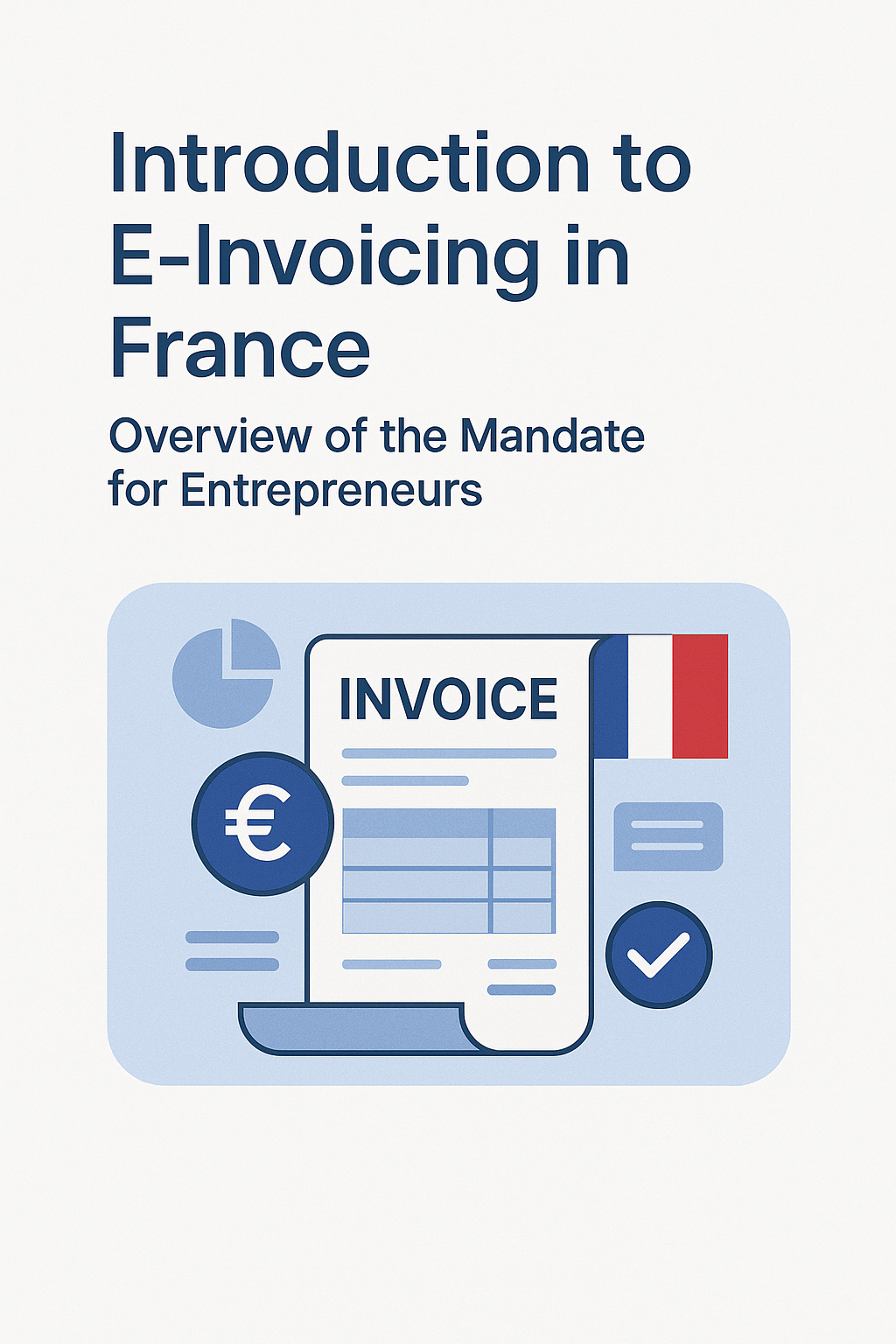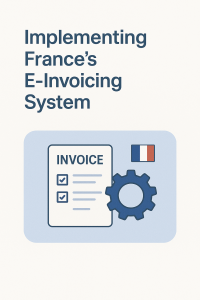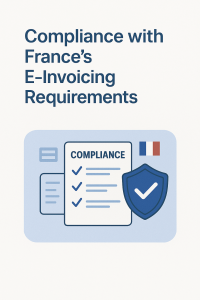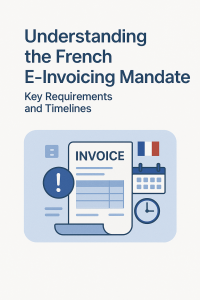Introduction: Beyond the Basics
In the first article of this series, we explored the foundations of France’s upcoming mandatory e-invoicing reform: why it exists, when it starts, and the overall architecture.
Now it’s time to dive deeper. This article explains exactly who is affected, what transactions are in scope, and what new obligations businesses must meet. If you are a foreign entrepreneur doing business in France, understanding these details will be critical for staying compliant and avoiding costly errors.
By the end of this article, you will know:
- Which transactions fall under e-invoicing and which under e-reporting
- What new mandatory data must appear on invoices
- How obligations differ for French-incorporated businesses vs. non-resident VAT-registered companies
- What this means for your day-to-day operations
Let’s break it down step by step.
Scope: E-Invoicing vs. E-Reporting
France has opted for a dual system:
- E-Invoicing (domestic B2B):
- Applies to all business-to-business transactions where both supplier and customer are established in France and the sale is subject to French VAT.
- Example: A Paris-based consulting firm issues an invoice to a Lyon-based client.
- E-Reporting (everything else):
- Applies to transactions that are not domestic B2B, including:
- B2C sales (goods and services sold to consumers in France)
- Cross-border B2B sales (exports and intra-EU supplies)
- Cross-border B2B purchases (imports and intra-EU acquisitions, with reporting obligations depending on flow)
- Example: A French online retailer sells to an individual consumer in Spain → reported via e-reporting, not e-invoicing.
- Applies to transactions that are not domestic B2B, including:
👉 Key takeaway: If you’re a foreign entrepreneur selling to French businesses via a local subsidiary, you’ll issue e-invoices for domestic B2B. If you are only VAT-registered without a French entity, your main duty will likely be e-reporting.
Special Case: B2G Transactions
Don’t forget that business-to-government (B2G) invoicing has already been mandatory since 2020 through the Chorus Pro portal.
- Any company invoicing a French public entity (ministries, hospitals, municipalities, etc.) must use Chorus Pro.
- The new reform does not replace Chorus Pro. Instead, it complements it for B2B and B2C/private transactions.
This means that if you sell both to the French State and to private companies, you will need to handle both Chorus Pro and the new e-invoicing system.
New Mandatory Invoice Data
In addition to standard VAT invoice requirements, France will enforce new mandatory fields starting September 2026/2027. These fields must appear in the structured data of your e-invoices, not just in free text.
The new elements are:
- Customer’s SIREN
- A 9-digit company identifier issued to all French businesses.
- Essential for routing invoices correctly through the directory system.
- Delivery Address
- Must be included if different from the client’s main address.
- Important for supply chain and VAT location rules.
- Operation Type
- Classify whether the transaction concerns:
- Goods
- Services
- Both
- Classify whether the transaction concerns:
- VAT on Debits
- If the supplier has opted for VAT accounting on debits instead of cash, this must be explicitly mentioned.
👉 These requirements apply from 1 September 2026 for large and intermediate-sized companies, and from 1 September 2027 for SMEs and micro-businesses.
Receiving vs. Issuing Obligations
Receiving
- From September 2026, all businesses registered for French VAT (including foreign entities with a French VAT number) must be able to receive e-invoices.
- This means you must have access to a system (either a PDP, PPF, or via a partner) capable of processing structured formats like Factur-X, UBL, or CII.
Issuing
- Issuing obligations depend on company size and establishment:
- French subsidiaries of foreign groups → must issue e-invoices for all domestic B2B transactions.
- Foreign businesses VAT-registered in France without a permanent establishment → generally not required to issue domestic e-invoices (since they are not “established”), but they may still need to e-report cross-border/B2C transactions and receive e-invoices from French suppliers.
Link with VAT Declarations
One of the main goals of the reform is to enable pre-filled VAT returns. Here’s how it will work:
- The DGFiP (French tax authority) will collect invoice and reporting data from PDPs/PPF.
- This data will be used to pre-fill periodic VAT returns, similar to how income tax pre-filling already works for individuals in France.
- Businesses will only need to verify, adjust, and confirm.
👉 For entrepreneurs, this means less manual data entry and lower risks of mismatches—but only if your invoices and reports are correctly submitted.
Data Retention Obligations
Invoices in France must be retained for 10 years under commercial law.
With e-invoicing:
- Invoices must remain readable, accessible, and unaltered throughout the retention period.
- PDPs and other providers may offer archiving solutions, but ultimately the legal responsibility remains with the business.
This means foreign entrepreneurs must ensure that their chosen service provider has compliant e-archiving capabilities.
The Role of the Central Directory
At the heart of France’s e-invoicing system is a central directory.
- It contains information about all VAT-registered businesses in France (SIREN, VAT number, chosen platform).
- It ensures that invoices are routed to the correct recipient.
- Businesses must ensure their data is accurate and up to date in this directory.
👉 For foreign entrepreneurs with a French VAT number, this means verifying that your SIREN and VAT ID are correctly listed, and that your chosen connection route (PDP or public portal) is registered.
Differences Between French-Incorporated and Non-Resident Businesses
If you incorporate a French company (subsidiary or branch):
- Full scope: must issue and receive e-invoices for domestic B2B.
- Must comply with e-reporting for B2C and cross-border.
- New invoice mentions are mandatory.
If you are non-resident but VAT-registered in France:
- Must receive e-invoices from French suppliers.
- Must comply with e-reporting obligations for certain sales/purchases.
- Typically do not issue domestic e-invoices (unless considered established).
If you are outside France with no VAT registration:
- No obligations until your activities create a VAT registration requirement.
Day-to-Day Business Impact
The reform will impact many daily processes:
- Invoice creation: Your ERP/accounting software must generate structured invoices with all required fields.
- Invoice reception: You’ll need a system that can process Factur-X/UBL/CII instead of only PDFs.
- Customer and supplier management: Master data must be accurate (SIREN, VAT numbers, addresses).
- Cash flow monitoring: Since payment statuses may be part of the lifecycle reporting, finance teams will need to reconcile data more closely.
- Compliance monitoring: Someone in your organization (or your accounting provider) must monitor compliance updates from DGFiP.
Example: A UK Entrepreneur with a French Subsidiary
Let’s say you operate a UK tech startup and decide to open a subsidiary in Paris.
- When selling B2B in France → you must issue e-invoices in Factur-X or UBL format via a PDP.
- When selling to French consumers → you must report sales via e-reporting.
- If you invoice a French ministry → you must use Chorus Pro.
- Your finance team will need to ensure SIREN and VAT IDs are included on all invoices, and that data is archived for 10 years.
Conclusion: Preparing for the Next Step
France’s e-invoicing reform goes far beyond switching from paper to digital. It introduces new data requirements, new processes, and a central directory system that businesses must adapt to.
For foreign entrepreneurs, the obligations differ depending on whether you create a local entity or simply operate under a French VAT number. Either way, you must be ready to receive e-invoices by September 2026 and to comply with reporting rules.
In Article 3 of this series, we’ll move from rules to action: how to prepare your business with a 90-day readiness plan. We’ll cover choosing a PDP, updating your ERP system, and ensuring your team understands the changes.




